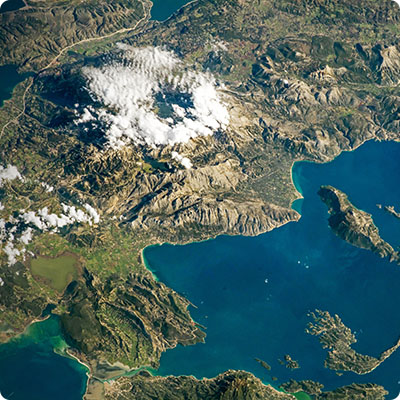Destinies
Rock paintings attest to the fact that Borneo has been inhabited for tens of thousands of years, a staggering figure reinforced by the first texts, of Chinese origin, mentioning the island and presenting it, as early as the first millennium AD, as a trading post. Trade meant crossroads where civilizations met, exchanged and mingled. Then came the power struggles between the European powers who tried to take over the territory, bringing in their wake new influences and new languages. Today, Borneo's unique situation - shared by three countries - confirms that the mixing of populations is still very much alive. Literature, for its part, has been nourished by this intermingling, first and foremost in its liveliest form - which is unfortunately also the most volatile - that of oral tradition. Mady Villard's name may be a little forgotten these days, but she impressed her fellow Frenchmen when, in 1975, she recounted in Bornéo, chez les hommes aux longues oreilles, how she had lived with a tribe deep in the jungle. This title is now out of print, but it's thanks to Mady Villard - and to Magali Tardivel-Lacombe, who accompanied her in this work - that we can discover a hitherto well-kept secret, the Tales and Legends of Borneo entrusted to her by the elders of several peoples - Kelabits, Kadazans, Muruts and Punans - which Editions Flies published in 2013 in their collection Aux origines du monde. Thirty-four tales featuring the dragon of Mount Kinabalu, a crocodile... and man-eating spirits will be discovered with delight, tenderness and, why not, a few shivers.
On the island, one thing's for sure: reality and fiction go hand in hand. The life of James Brooke was so incredible that the famous British anthropologist Nigel Barley devoted a biography to him, published in French by Payot under the title Un rajah blanc à Bornéo (A white rajah in Borneo). As his name suggests, the "Sir" was born of an English father, then an administrator with the East India Company, so it was in Benares that he was born on April 29, 1803. Heir to a handsome sum of £30,000 at the age of 32, he bought himself a ship and set sail for Kuching, capital of Sarawak, then in the midst of a conflict with Brunei. Brooke improvised as a moderator, earning himself the status of "rajah" and international renown. On his death in 1868, his nephew Charles Anthony Johnson Brooke inherited his status as "viceroy" of Sarawak, but it was his wife, Margaret, who forged a fine reputation for herself with her memoirs, republished in French in 2022 by Magellan & Cie. In this book - Reine à Bornéo : souvenirs d'une vie singulière (1849-1936) - the "lady" who became a "rani" recounts with great frankness her daily life, far removed from her Parisian childhood, but oscillating smoothly between Victorian good society and the Malay community where she had forged friendships. It was also at the age of 20 that Carl Bock (1849-1932), a native of Denmark, landed in Borneo and was commissioned by the Governor General of the Dutch East Indies to explore the interior of the Southeast. His report - first published in 1881 and subsequently reworked - was a great success... but also contributed to giving the island a somewhat sulphurous image, as the deliberately catchy title: Headhunters of Borneo(Chez les Cannibales de Bornéo, BNF editions) suggests.
Adventures
Less versed in sensationalism because more accustomed to handling the pen, it was then two writers who lingered in Borneo and delivered their own vision of it: Joseph Conrad (1857-1924), who made at least four stopovers there around 1887, and Somerset Maugham (1874-1965), who traveled extensively in the 1920s, particularly in Asia. Maugham's first novel, La Folie Almayer (published by Autrement), takes the island as its setting and an aging man as its anti-hero, while his short stories include at least Le Sortilège malais (The Malay Spell), in which an Irish planter dies from the spell cast on him by his Malay wife, who has abandoned him. After these fictions - which are clearly influenced by the special atmosphere of Borneo - the waltz of scientists, explorers and journalists resumes. These include Swedish ethnologist Eric Mjöberg, who was curator of the State Museum of Surawak from 1922 to 1924, then died in 1938 after a strange illness that saw him haunted by the spirits he had studied in Australia, and Briton Owen Rutter, whose writings have not been translated into our language either(Pagans of North Borneo, 1929). As for their female counterparts, it would be impossible not to think of Élisabeth Sauvy, better known by her pseudonym, Titaÿna. This journalist, born in 1897 in Villeneuve-de-la-Raho (Pyrénées-Orientales), was one of the first to earn the title of "grand reporter" between the wars, thanks to her long journeys punctuated by intrepid adventures. The second half of her life was less glorious: condemned for collaboration, she suffered opprobrium and oblivion in San Francisco, where she died, perhaps committing suicide, in 1966. Nevertheless, Marchialy Editions has decided to republish her long-form reports, including Une femme chez les chasseurs de têtes (A Woman Among the Headhunters ), which is not set in Borneo, where she did her research, but among the Toraja of South Sulawesi, a province of Indonesia just a stone's throw away.
Agnes Newton Keith (1901-1982) also lived an unusual life. After a career in journalism was cut short by a terrible attack, she left her native America to join her husband, a forest administrator in northern Borneo. Her first five years in Sandakan were idyllic, and inspired Land Below the Wind, first published as a serial and then as a collection. Alas, war broke out and in 1942 the Japanese landed, paradise became hell, and Agnes was imprisoned with her family in a camp from which they were not released until 1945. The diary she kept in secret was later used to write an autobiographical account, Three Came Home, which was later adapted for the screen. Her Borneo trilogy ended with White Man Returns, but unfortunately none of these three titles has been translated into French. Anyone interested in this period should try to pick up Judith M. Heimann's The Last of the Last: The Extraordinary Life of English Anthropologist Tom Harrisson (Octares). Heimann (Editions Octares, 2005), a biography of a scientist who spent most of his life in Sarawak, or look for these three titles on the second-hand market : Un Royaume en or by Vitold de Golish (Flammarion, 1970), Un Étranger dans la forêt : jusqu'au bout des mystères de Bornéo by Eric Hansen (Albin Michel, 1990) and Au cœur de Bornéo by Redmond O'Hanlon (Payot, 2001).
Commitments
As times change, so adventure literature evolves. It's no longer a question of sporting feats or fascination with anthropophagy, but rather of worrying about the disappearance of what once was: rituals, animal species, biotopes... While Wade Davis, an anthropologist born in Canada in 1953, wrote Penan Voice of the Borneo, as yet untranslated, he is also the author of Notre monde a besoin de la sagesse ancestrale, a work that explains his philosophy and concerns, to be discovered by Albin Michel. Bruno Manser, one year his junior, was born in Basel and has been missing since 2000. At the age of 30, he left his native Switzerland for Borneo, dreaming of integrating among the nomadic Penan people, who had become shepherds by choice rather than doctors as his parents would have wished. He documented at length his apprenticeship back to nature, and soon became alarmed at the deforestation threatening both wildlife and ancestral ways of life, prompting the community that had welcomed him to rebel. His book - Voices from the Rainforest: Testimonies of a Threatened People - is long out of print, but a biography by Ruedi Suter, Bruno Manser: Voice of the Forest, was published in 2020 by Black-star (s)éditions. A second, by Carl Hoffman, has not yet been translated, and is entitled The Last Wild Men of Borneo: A True Story of Death and Treasure. It also features Michael Palmieri, a specialist in tribal art who is also passionate about the island... but for other reasons. Finally, Aurélien Brulé, born in 1979 in the Var region of France, has adopted as his pseudonym the name of the species to which he has dedicated his life: the gibbon, Chanee in Thai. Founder of the Kalaweit association, based in Borneo and Sumatra, he has also published a dozen books, including Bornéo : au nom de la vie and Hâte d'être à demain pour continuer à sauver... published by Presses du Midi.
In conclusion, Robert Raymer is one of the few writers to use fiction to give us an idea of contemporary reality on the island to which he expatriated from the United States. Now living in Sarawak, his collection of short stories Trois autres Malaisie was translated into French by Globe Editions in 2011. Once again, this voice evoking Borneo is not a native one, as authors with a direct link to the island of three countries are rare or non-existent in French.
We can only draw on the list of winners of the SEA Write Award, the Southeast Asian literary prize, to discover writers linked to Brunei - even if their works remain distant to us - Jamil Al-Sufri (1921-2021), Yahya bin Ibrahim (1939-2022), Muslim bin Burut (1943-2021) or Hajah Norsiah binti Haji Abdul Gapar, the 2009 winner born in 1952. We could also mention Chang Kuei-hsing, who was born in Sarawak in 1956 but seems to have taken Taiwanese nationality after moving there at the age of 20 for his studies. His books are set on his two islands, his birthplace and his adopted home, and are affiliated with the so-called magic realism movement. They often feature animals, worthy representatives of their human cousins, and are also concerned with ecological issues. The various awards they have received give us hope that we will one day have the pleasure of discovering Herd of Elephants, Monkey Cup or When Wild Boars Cross the River in our language. Chang Kuei-hsing never forgets that he hails from the Chinese community, and in this respect we might compare him with two writers close to Kuala Lumpur: Shih-Li Kow and Tan Twan Eng, both of whom write in English. The former has perfected her art of portraiture and through her characters draws up that of a multicultural society, she is discovered by Zulma with La Somme de nos folies , which received the Prix du premier roman étranger in 2018. The second is more devoted to spy novels, notably with Le Jardin des brumes du soir and Le Don de la pluie, which have met with nice success with Flammarion. Finally, Tash Aw, who grew up in Kuala Lumpur, was shortlisted for the Booker Prize for Le Tristement célèbre Johnny Lim (10-18), and is pursuing a fine literary career with La Carte du monde invisible (10-18), Un Milliardaire cinq étoiles (Robert Laffont), then Nous, les survivants and Étrangers sur la grève in the Fayard catalog. All three cosmopolitans, they have traveled extensively and often lived far from the capital of Malaysia, as has Tash Aw, who has taken to writing in France.















